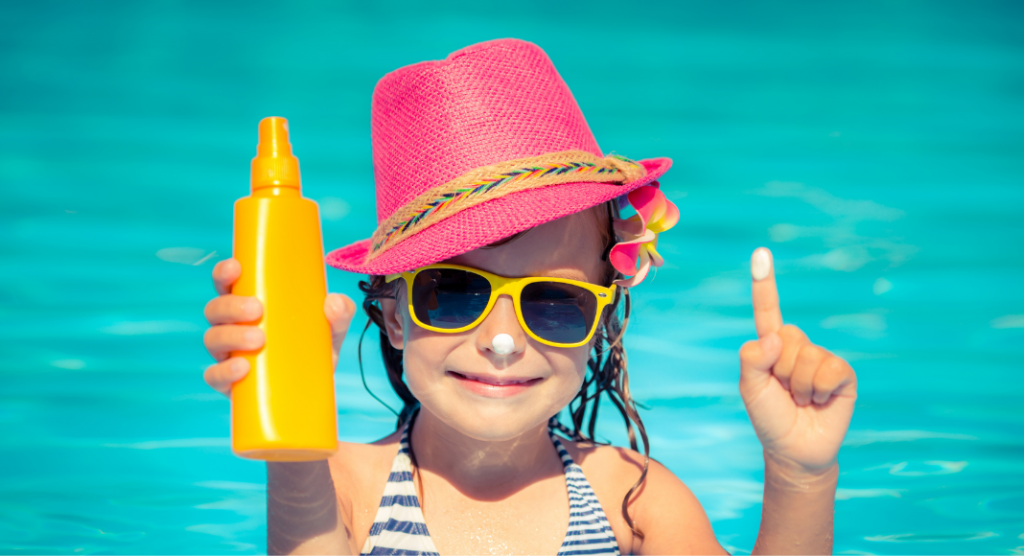 Summer is here, and there is a particular summer smell that always takes me back to my childhood. The scent recalls vividly an early summer morning…
Summer is here, and there is a particular summer smell that always takes me back to my childhood. The scent recalls vividly an early summer morning…
My sister and I were in the driveway wearing our swimsuits while heckling our poor mother as she loaded the car full of towels, floats, diving sticks, drinks, and poolside snacks for a day of swimming. The anticipation grew our hyperactivity and impatience during the pack, the drive, and in the pool parking lot. We rush in, the open pool within diving distance when our mom gives us the dreaded “Nah uh uh. Not before you put on your sunscreen and let it dry.”
We are rubbed down in the white goo. We sit with frowns on our faces; our only company the intoxicating smell of Banana Boat that hugged us as our true friends splash in the water. Then, at last, our mother releases us into the great blue, and we make the most wonderful memories, our skin protected from a threat we didn’t understand.
Now, as an adult, I can retroactively appreciate my mom’s diligence. Most of us now understand that the threat of sun damage and cancer exists. We may know to protect ourselves and our children with sunscreen. But do we know HOW sunscreen protects us? And how can we know which sunscreen provides the best protection considering our activity type and duration, age, skin type, and other needs or concerns?
That’s where I come in! I’ve done the research so you don’t have to. I’ll detail the basics of sunscreen to aid your decision-making process so you and your children may have optimal skin protection and healthy, confident summer.
How To Choose The Best Sunscreen For Your Family
Sunscreen Types
Sunscreens work in one of two ways:
Physical sunscreens: These contain molecules (like zinc oxide or titanium dioxide) that physically reflect the sun’s UV rays away from the skin. Think of how you paint a house white to reflect the sun and reduce energy costs. This is similar. Have you ever seen an older picture of a beach-goer with a white sunscreen nose? Same thing! Now manufacturers are able to make these inorganic particles much smaller, so we aren’t left with a ghost-white face. Most dermatologists recommend using these sunscreens, especially for more sensitive skin types. Look for “mineral-based” sunscreens when shopping for these.
Chemical sunscreens: The chemicals (like avobenzone, aminobenzoic acid, oxybenzone, to name a few) in these sunscreens absorb the UV rays before they can hit the skin. The radiation breaks the bonds down, and that energy is released as heat. So, as with all sunscreen, be sure to reapply often!
Decoding Sunscreen Jargon
Company ads will try to claim their sunscreen as the best, and labels can often be misleading. Educating yourself is the best way to see through tricky marketing. Picking the best sunscreen for you can be very simple with just a little bit of knowledge!
There are 3 types of UV light; UVA, UVB, and UVC.
- UVC rays are blocked by the Earth’s ozone layer, so they are not a concern in considering skin protection.
- UVB rays are the main cause of sunburns (think ‘B’ for ‘Burn’) and skin damage related to cancer. As such, most sunscreens primarily protect against this type of UV radiation.
- UVA rays penetrate deepest into the skin; these are the main cause of tanning and long-term skin damage such as wrinkles and some types of cancer.
Broad spectrum sunscreen protects against both UVB and UVA protection.
What is SPF (Sun Protection Factor)?
This measurement refers to how well a sunblock protects against UVB radiation ONLY. There is no standardized measurement for UVA protection, so be sure to look for the label “broad spectrum” if you are wanting to protect against both. The American Academy of Dermatology and Skin Cancer Foundation recommend using an SPF between 15 and 50, and reapplying every two hours. While there has been no significant proof that an SPF above 50 works any better than SPF 50, it is up to you to decide what gives you the best peace of mind.
 Skin Types and Sun-Protection Needs
Skin Types and Sun-Protection Needs
Does your baby have eczema? Does your child jump in the pool before their sunscreen has time to fully dry? Is it impossible to get them back two hours later to reapply? Our children’s sun protection needs are as varied as they are.
Here is a roundup of the top picks for various needs according to Prevention.com, Parents.com, Health.com, and the Environmental Working Group (EWG). All of these are benzene-free and broad-spectrum.
- Baby Eczema: Pure & Free Baby Sunscreen SPF 50 (Neutrogena)
- Tear-Free: Pure & Simple Baby Mineral Sunscreen Lotion SPF 50 (Coppertone)
- Hydrating: Baby Sunscreen Lotion Broad Spectrum SPF 45 (CeraVe)
- Sensitive Skin: Baby Sunscreen Cream SPF 30 (Badger) for infants/toddlers, and Kids Sunscreen SPF 30 (Badger) is their formula for older children
- Easiest Rub In: Baby Skin Mineral Sunscreen SPF 50 (Babo Botanicals)
- Longest Lasting: Baby Continuous Protection Sensitive Skin SPF 50 (Aveeno) for infants, or Anthelios Dermo Kids Sunscreen SPF 60 (La Roche-Posay) for older children. Both last 80 minutes, which is typical for longer-lasting sunscreens.
- Active/Sports Sunscreen: Kids Safe Sunscreen SPF 50+ (ThinkSport)
- Vegan/Cruelty-Free: Mineral Sunscreen Lotion SPF 50 (Baby Bum) is given the highest safety score for kids by the EWG.
- Smart Technology: The bottle of Australian Baby Mineral Sunscreen SPF 50+ (Blue Lizard) turns pink when harmful UV rays are present. This could be used as a fun way to countdown to reapplication time with your children. Tell them “once the bottle turns from white to pink, it’s time to reapply.” Make a game of it! Hide the bottle with a towel until the five-minute countdown to reapplying.
- Environmentally Friendly: Safe Sunscreen SPF 50+ (Thinkbaby) for younger children, and Kid’s Mineral Sunscreen SPF 40 (All Good Makes Everything Better) for older children.
- Plant-Based: Baby Sunscreen Lotion SPF 50 (Babyganics) for younger children or Kids Sunscreen SPF 30 (Kiss My Face) for older kids
Concerns with Sunscreen Ingredients
The recommendation for mineral/physical sunscreen over chemicals comes from growing evidence that some of the organic material in chemical sunscreen is absorbed through the skin and into the bloodstream. This itself does not mean they are unsafe. Some studies have shown that oxybenzone may disrupt hormones in mice. However, it is worth noting that these mice were fed high quantities of oxybenzone, and it would take 277 years of regular sunscreen application to achieve the same systemic dose in humans.
There is not enough evidence that chemical sunscreens cause genetic damage in humans with typical use. The FDA clears all sunscreens before production and issues recalls when new evidence presents a sunscreen as potentially harmful. Whatever you ultimately decide to use will be OK. You’ve done your research and are doing an awesome job.
 Other Methods of Sun Protection
Other Methods of Sun Protection
It is not recommended to use sunscreen on babies under six months old, and it is recommended that they avoid direct sunlight altogether. If you plan to take them outside (especially in the summer), be sure to use other methods of sun protection. Find some shade and keep them covered. This can include SPF clothing or a hat, natural shade from trees, or make your own shade with an umbrella. Cover their play area/seat/carrier with a light, airy cover. Finding the shade is a great idea for older children as well.
Remember, when choosing sunscreen look closely at the ingredients to decide what works best for you and your children’s needs. And be sure to use the info currently available to you to make the very best choices for your kids at any given time. In fact, by reading this post, you’re doing just that right now!
Happy swimming!














